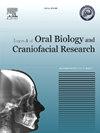Evaluation of exo-long noncoding RNA MALAT1 in OSCC in comparison to dysplastic and normal: A cross-sectional study
Q1 Medicine
Journal of oral biology and craniofacial research
Pub Date : 2025-01-01
DOI:10.1016/j.jobcr.2024.12.018
引用次数: 0
Abstract
Objective
This study explores the role of MALAT1 as a valuable target for creating minimally-invasive diagnostic methods and personalized treatments in the management of OSCC. It focuses on evaluating the role of exosomal MALAT1 in the progression of dysplasia to OSCC by influencing the PI3K/AKT pathway.
Method
This cross-sectional study evaluated MALAT1 expression and PI3K/AKT pathway components in exosomes derived from plasma samples of patients with various stages of oral dysplasia, OSCC and compared with normal. RNA concentration was estimated, real-time polymerase chain reaction (qPCR) was used for quantitative analysis. Gene expression levels of MALAT1, PI3K, AKT1, and PTEN were analysed and compared across groups using one way ANOVA and Post-hoc Tukey analysis was performed for pairwise comparisons to assess correlations between MALAT1 expression and PI3K/AKT pathway components.
Result
MALAT1 was found to be overexpressed in OSCC in comparison to normal, significantly (p < 0.001∗). There was no significant change in expression pattern of MALAT1 between dysplastic patients and normal, yet, significant association was found on corelation analysis between expression pattern of MALAT1 and PI3K/AKT/PTEN (p 0.001∗) among individuals of dysplasia and OSCC. As well pairwise comparisons of MALAT1 expression levels between all three stages of dysplasia showed significant association (p < 0.001∗).
Conclusion
MALAT1 stands out as a key player in the complex landscape of OSCC pathogenesis, impacting tumorigenesis, metastasis, and treatment outcomes through multifaceted molecular mechanisms. Continued research into MALAT1's regulatory roles and its interactions within the tumor microenvironment holds promise for uncovering novel therapeutic targets and biomarkers that could redefine the management of OSCC in the future.

评估外显子非编码RNA MALAT1在OSCC中与发育不良和正常的比较:一项横断面研究。
目的:本研究探讨MALAT1作为一种有价值的靶点,在OSCC的微创诊断方法和个性化治疗中所起的作用。本研究的重点是通过影响PI3K/AKT通路来评估外泌体MALAT1在异常增生到OSCC的进展中的作用。方法:本横断面研究评估了来自不同阶段口腔发育不良、OSCC患者血浆样本的外泌体中MALAT1的表达和PI3K/AKT通路组分,并与正常人进行了比较。测定RNA浓度,采用实时聚合酶链反应(qPCR)进行定量分析。对MALAT1、PI3K、AKT1和PTEN的基因表达水平进行单因素方差分析和事后Tukey分析进行两两比较,以评估MALAT1表达与PI3K/AKT通路成分之间的相关性。结果:与正常细胞相比,MALAT1在OSCC中过表达,在异常增生和OSCC个体中显著(p p 0.001 *)。结论:MALAT1在OSCC复杂的发病机制中发挥着关键作用,通过多方面的分子机制影响肿瘤的发生、转移和治疗结果。对MALAT1的调控作用及其在肿瘤微环境中的相互作用的持续研究有望发现新的治疗靶点和生物标志物,这些靶点和生物标志物可能在未来重新定义OSCC的管理。
本文章由计算机程序翻译,如有差异,请以英文原文为准。
求助全文
约1分钟内获得全文
求助全文
来源期刊

Journal of oral biology and craniofacial research
Medicine-Otorhinolaryngology
CiteScore
4.90
自引率
0.00%
发文量
133
审稿时长
167 days
期刊介绍:
Journal of Oral Biology and Craniofacial Research (JOBCR)is the official journal of the Craniofacial Research Foundation (CRF). The journal aims to provide a common platform for both clinical and translational research and to promote interdisciplinary sciences in craniofacial region. JOBCR publishes content that includes diseases, injuries and defects in the head, neck, face, jaws and the hard and soft tissues of the mouth and jaws and face region; diagnosis and medical management of diseases specific to the orofacial tissues and of oral manifestations of systemic diseases; studies on identifying populations at risk of oral disease or in need of specific care, and comparing regional, environmental, social, and access similarities and differences in dental care between populations; diseases of the mouth and related structures like salivary glands, temporomandibular joints, facial muscles and perioral skin; biomedical engineering, tissue engineering and stem cells. The journal publishes reviews, commentaries, peer-reviewed original research articles, short communication, and case reports.
 求助内容:
求助内容: 应助结果提醒方式:
应助结果提醒方式:


